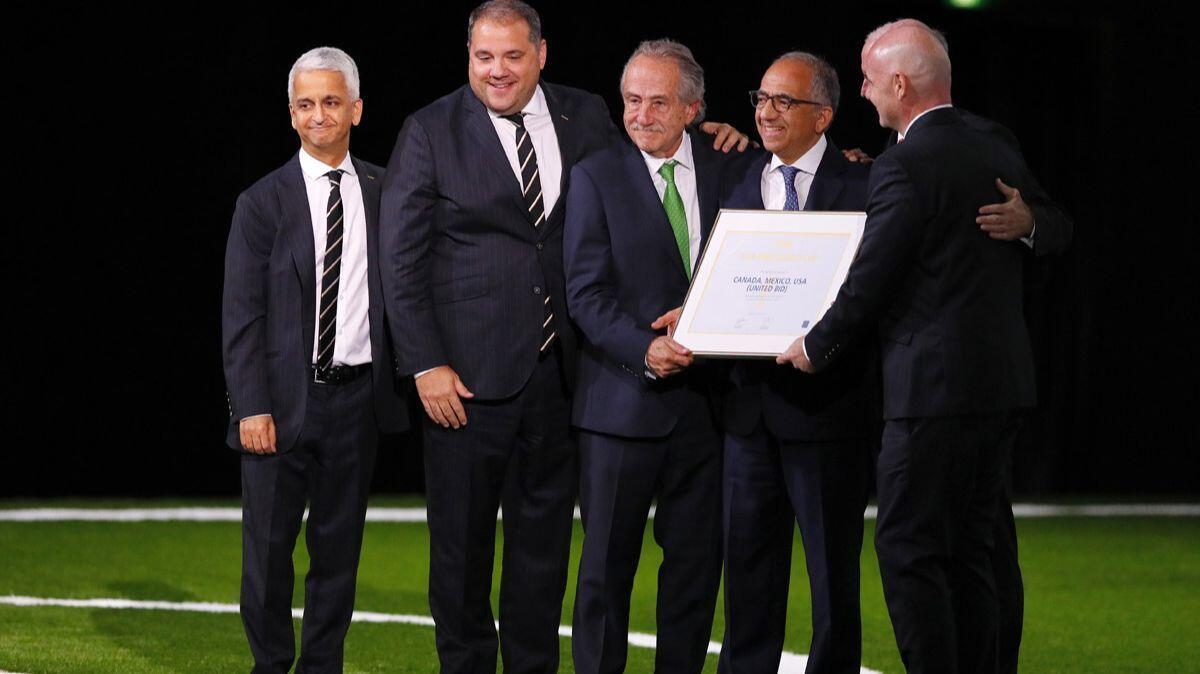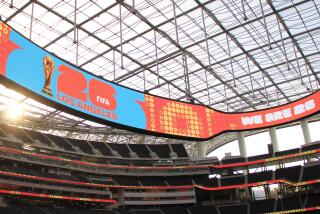World Cup: Sunil Gulati deserves an assist for bringing 2026 World Cup to North America
- Share via
Reporting from moscow — A little over an hour after FIFA awarded the 2026 World Cup to the U.S., Mexico and Canada earlier this month, the three co-chairmen of the United 2026 bid committee took the stage for a news conference at Moscow’s sprawling Expo Center.
Carlos Cordeiro, president of the U.S. Soccer Federation, Canadian Soccer Assn. leader Steven Reed and Decio de Maria, president of the Mexican Football Federation, all wore crisp suits and wide smiles as they answered questions and accepted congratulations for bringing the world’s biggest sporting event back to North America.
In the third row of the press seats, near the foot of the stage but out of the spotlight, Sunil Gulati sat alone, one leg crossed over the other. If Cordeiro, Reed and De Maria had combined to get the ball over the goal line, Gulati, the former USSF president and the bid committee’s first chair, was the playmaking midfielder who had done the hard and thankless work of bringing the ball up the field.
“I’m not sure I would use that analogy,” Gulati said over breakfast Friday. “It’s a 90-minute game and you captain for 80 minutes, but in the end we won.”
Gulati was on the bench for the final push, replaced as USSF president by Cordeiro in February. But if he has become the forgotten man behind the bid, his contributions can’t be as easily dismissed.
It was Gulati who, nearly four years ago, began the conversations with officials in Mexico and Canada that brought the bid to life. It was Gulati who, despite advice to the contrary, insisted on sharing the World Cup with the rest of North America when the bid was launched in April 2017.
And it was Gulati who, after the 2018 and 2022 World Cups were awarded to Russia and Qatar, respectively, in votes that have been investigated for bribery and corruption, insisted that FIFA change its rules before the U.S. would consider bidding for the World Cup again.
All those decisions proved prescient.
“Sunil Gulati was the genius behind the effort,” said Scott LeTellier, the chief executive of the 1994 World Cup, the only other World Cup held in the U.S. “As president of U.S. Soccer, he forced FIFA’s hand to implement bid reforms that gave us a chance to win. As a member of the FIFA executive committee, he recognized vulnerabilities in a standalone U.S. bid, conceptualized the United bid and struck deals with Mexico and Canada to actively support it.”

There were others, LeTellier added, who played anonymous yet vital roles behind the scenes, such as John Kristick, who worked with Le Tellier and Gulati on the 1994 World Cup, then produced the 70,000-page bid document this time around.
“It was a huge effort by a lot of people,” Gulati agreed. “You don’t do these things alone.”
The foundation for the 2026 bid was built in the wreckage of a similar effort in 2010, when 14 of 22 members of FIFA’s executive committee rejected a U.S. bid and awarded the 2022 World Cup to Qatar, a tiny desert emirate with no soccer tradition.
Gulati, then in his second term as USSF president, and Cordeiro, a member of the federation board, worked on the bid together and both were crushed by the result.
“Right after Qatar was selected, a lot of things go through your head. And for me there were two very divergent ones,” Gulati said. “One is I never want to go through this process again. And two is, let’s start [over] right now.
“And in the end we opted for the latter and started thinking about it.”
“Right now” turned out to be four years later, with Gulati waiting until after the 2014 World Cup to begin informal discussions with Victor Montagliani, former president of the Canadian Soccer Assn., and Emilio Azcárraga Jean, CEO of Mexican television giant Televisa, whose family had been instrumental in bringing the 1970 and 1986 World Cups to Mexico.
“We were having those two sets of bilateral discussions,” Gulati said. “The one with Mexico, both for Emilio and I, was about more than just the sport. Or a bid. It was about some of the issues that are in the news these days.”
Issues such as relations between the U.S. and Mexico, immigration and other thorny problems and how cooperation between the two soccer federations, whose national teams are bitter rivals, might improve them.
“That was part of the rational, certainly with Mexico,” Gulati said.
Getting the Mexican and Canadian federations to buy in to the idea of a combined bid proved easier than convincing the soccer community in the U.S., though. The country had the wealth, infrastructure and institutional know-how to put on a World Cup by itself, even one that would be expanding to 48 teams and 80 games. So why share it?
Gulati countered that a NAFTA World Cup, shared across two borders, would not only set an example of friendship and cooperation, but on a practical level it might prevent both Mexico and Canada from mounting rival bids for the 2026 event, as both had talked of doing.
“I’d rather have a 90% chance of getting 75% of the World Cup than a 75% chance of getting 100% of it,” Gulati told the USSF board. “The thought [was] that Canada and Mexico would be great partners and it would help the bid. Which I think it did.
“All three countries brought some unique attributes to the bid. And will bring some unique attributes to the World Cup itself.”
But if Gulati did much of the heavy lifting, Cordeiro made the decision that ultimately proved decisive, reorganizing the bid committee a month after replacing Gulati as USSF president. Under Gulati, the U.S. Soccer president chaired the group; Cordeiro split the duties equally among the three presidents.
Until then, the United 2026 bid had been flagging, but with Cordeiro, Reed and De Maria now able to lobby other FIFA federation leaders on equal footing, the committee regained the momentum. In late spring, the three presidents set up shop in London, finishing a sprint that saw them combine to meet with approximately 150 federation presidents or their deputies in the final months before the vote.
“There’s been a huge effort to really do it as a united bid,” Cordeiro said. “We talk a lot about what it means to be united, and we really do think we’re stronger as three nations than as one.
“I think we changed the whole face of the bid. The fact that we had three co-chairs has been received very, very well. On an initiative such as this, we have to work together.”
FIFA voters agreed, overwhelmingly backing United 2026 over a bid from Morocco by 134 to 65. An hour after the results were in, Cordeiro, Reed and De Maria took the stage and explained how it happened while Gulati sat by himself in the audience and watched.
“The federation was able to do a victory lap, which was the most important thing,” he said. “A lot of people had a lot to do with what happened. Which is great.”
kevin.baxter@latimes.com | Twitter: @kbaxter11







